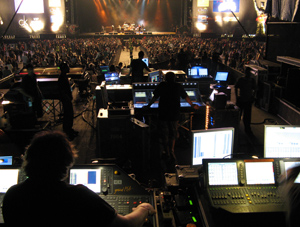 It seems only yesterday that ‘serious’ live mixing consoles were big things. Physically big things...
It seems only yesterday that ‘serious’ live mixing consoles were big things. Physically big things...
Before digital, desks were ten feet across, weighed 300 kilos, needed a platoon of roadies just to get the case lid off and were accompanied by racks of flashing lights and LED ladders. It’s hard to know who was more impressed – the nearby audience or the FOH engineers.
The opportunity to mix on one of these beasts was a rite of passage for many, most of whom had learned their craft on rinky-dink desks in pubs and clubs.
Then a Japanese company set out to demonstrate that digital consoles were not destined to remain an expensive, esoteric, academic engineering excercise. On the contrary, digital desks could be made smaller and lighter, while providing almost unlimited numbers of inputs and outputs, and offering stacks of onboard processing that would get rid of those pesky racks. Best of all, they could approach the Holy Grail of mixing... total recall.
Wind the clock forward ten-ish years, and all these things – and many more – have come to pass. Digital consoles have, without question, changed the way many engineers work. There are even productions that would not be technically feasible without them. Live consoles are now a fraction of the size and weight they were. Many are used without any outboard gear at all, and in most cases it is possible to store complete shows on portable mini-media that engineers carry from place-to-place. It’s all good.
 The benefits of digital consoles are particularly relevant to PA rental companies, who were quick to realise this and embrace the technology. Digital mixing systems usually eliminate significant non-invoiceable costs because they do not require the expensive infrastructure of cases, racks, outboard kit, power and signal distribution that large analogue systems do, plus they are significantly cheaper to transport, deploy and store. They are also cheap. In fact, they are very cheap, if you compare analogue/digital pricing in terms of available features, I/O count and operational efficiency.
The benefits of digital consoles are particularly relevant to PA rental companies, who were quick to realise this and embrace the technology. Digital mixing systems usually eliminate significant non-invoiceable costs because they do not require the expensive infrastructure of cases, racks, outboard kit, power and signal distribution that large analogue systems do, plus they are significantly cheaper to transport, deploy and store. They are also cheap. In fact, they are very cheap, if you compare analogue/digital pricing in terms of available features, I/O count and operational efficiency.
Because the technology is relatively new they also tend to suffer from apocalyptic depreciation, but that will probably improve in time.
Rise time
The inexorable rise of digital has also brought a new dawn to several existing console manufacturers, as well as prompting the emergence of new players who had no analogue background at all.
Some long-established manufacturing names were experiencing a long, slow demise in the old analogue world, which (certainly at the mid-to-top market sectors) was mostly divided between a Japanese digital desk pioneer and a smaller but very hip UK company. But those old-world players have almost all reinvented themselves by applying their brand equity to digital products, mostly very successfully.
It’s an interesting and relevant coincidence that the major developments in digital mixing technology have taken place concurrently with huge advantages in loudspeaker technology – especially line-source systems.
As big PA systems have become more efficient, more predictable and with unprecedented directional control, they have also become far less forgiving. Most now reproduce their input signals with ruthless power and clarity, which places much greater demands on both the upstream technology and the engineer. A really good large-scale PA (of which there are now many) will faithfully deliver a ‘loud version’ of whatever it receives to every seat in the house with minimal SPL or tonal variance, making the quality of the input signal more important than ever before.
Why relevant? Because the emergence of these systems has contributed to the growing realisation that digital consoles are superior to analogue in every possible way, except the one which should really matter above all else – sound quality.
Quality control – good enough?
 Now that (almost) everyone has managed to get over the initial ‘OMG, look at that!’ factor, some engineers – including some working with acts of the highest global calibre – have looked up from their displays, re-focused their ears onto what’s coming out of the PA, and realised that the trade-off between audio performance and convenient functions is in debit, especially for certain types of performance. Muse and AC/DC are just two examples of major acts being mixed on resolutely analogue systems. And there are others, suggesting that this is no indulgence or aberration.
Now that (almost) everyone has managed to get over the initial ‘OMG, look at that!’ factor, some engineers – including some working with acts of the highest global calibre – have looked up from their displays, re-focused their ears onto what’s coming out of the PA, and realised that the trade-off between audio performance and convenient functions is in debit, especially for certain types of performance. Muse and AC/DC are just two examples of major acts being mixed on resolutely analogue systems. And there are others, suggesting that this is no indulgence or aberration.
The result of this, and the legacy of old desks still in use, means that the analogue console ‘tail’ is already longer than most console manufacturers has expected. And it looks, at least for the moment, as if it’s not in a hurry get any shorter.
If this situation is weighed against the global backdrop of comparable technologies, the sad conclusion is that we live in a world of ‘good enough’. Digital consoles stand comparison with miniature personal music players – the audio performance is considered adequate but only in comparison to the operational and convenience benefits they offer, which actually form the whole sales strategy for the product. When did you last hear someone say that they like their MP3 player because it sounds so good? Have you ever seen an ad for one of these things that even mentions audio quality?
The commercial and operational benefits make a compelling argument for digital mixing consoles, but do they actually contribute to the core role of an audio mixing system – the creation and delivery of a great sound mix? No, right now they don’t. Will they in future, as the technology matures? Who knows?
This extraordinary business of pro audio is characterised, even defined, by a fierce determination to do what we do as well as it can possibly be done – to make it sound great for everyone in the house. Has this pride in our own performance been undermined by the appearance of technology that doesn’t sound great, but seduces us with its power and convenience? And is that pride currently being rediscovered by a few engineers who are making console choices based on both audio performance and user features?
You decide...
Our source, Audio Boy, is an audio industry insider, following the Fast-and-Wide brief.